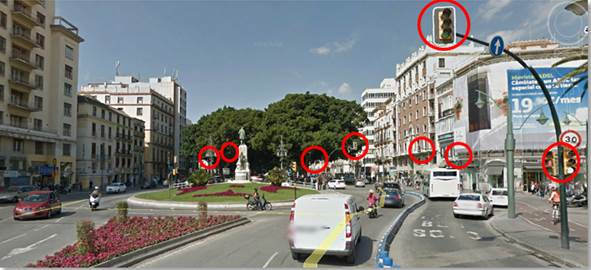We all know that each time there are more and more cars on our roads; therefore, the traffic jams are very common.
By other side, there is a great concern about contamination.
But, designing a proper plan cycle traffic lights to avoid traffic jams and reduce emissions is possible according to a set of computer work at the University of Málaga and the Universidad Nacional del Sur (UNS) in Bahia Blanca (Argentina).
Specifically they have designed a computing system that allows you to control the entire network of traffic lights in a city, whose results have been published in the "IEEE Trans. on Evolutionary Computation" magazine, reports the Discover Foundation.

Traffic lights in the main Alameda of Malaga
"The system includes as variables the many vehicles of various types circulating daily, signals, speed limits of the roads. It combine parameters and transfers them to a simulator, where all of them are observed while dynamically”, said the professor of the University of Málaga, Enrique Alba.
A new feature of the project is the methodology used to control traffic lights. In Particle Swarm Optimization (PSO) name, is a technique inspired by the movements of flocks of birds during their migrations.
These patterns are a powerful computational model that combines a multitude of variables to recreate the events surrounding urban mobility at one time, for example, a moving rush hour.
"Controlling the time when they will be in a hundred red lights is a task that requires complex solutions that combine data from maps geopositioned smart mobility. Traditional computing techniques do not work. We seek alternatives in nature itself, with the bio-inspired techniques called”, Alba has qualified.
Experts reproduce the city moving the math a microscopic traffic simulator. "It is so named because it caters to the micro-details of urban mobility: analyzes each car, how fast or how many will is emitting polluting gases", has finalized the researcher.
The study results have been tested with semaphores of two large metropolitan areas: Málaga and Bahia Blanca in Argentina. "Our algorithm is used to obtain efficient programs traffic light cycles for the two types of cities: the American and European models", specified.
The study concludes that, compared with other programs, the University of Málaga quantitative improvements achieved in the number of vehicles arriving at their destination, as the total travel time. These benefits for citizens, in addition to environmental, as emissions are reduc Several national and international councils of cities and related ciudaddes smart (smart cities) and have been interested in the study to incorporate their results in traffic control centers companies. "The next step would be for a company to market the system as a software package", Alba has advanced.
I hope that you have liked this post.
Till soon, kind regards,
Luis.
Sponsored by Costaluz Lawyers.
Please click down here:
